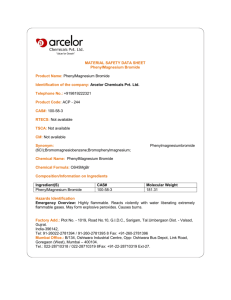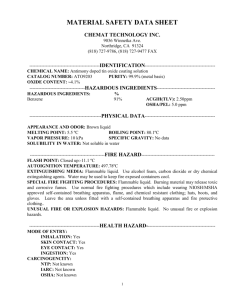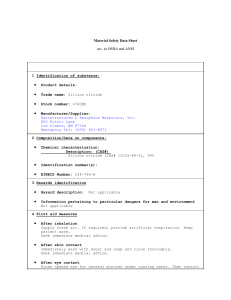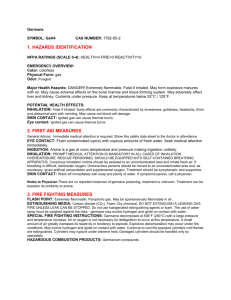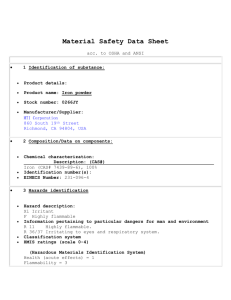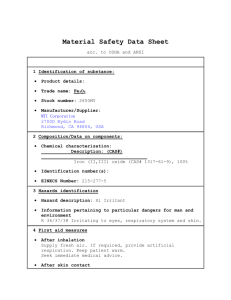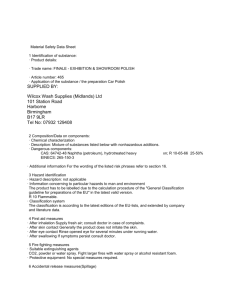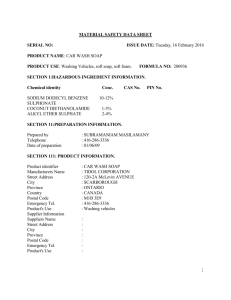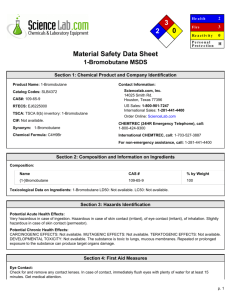7246 1-Bromobutane (English) AAA TCI MSDS A2.0
advertisement
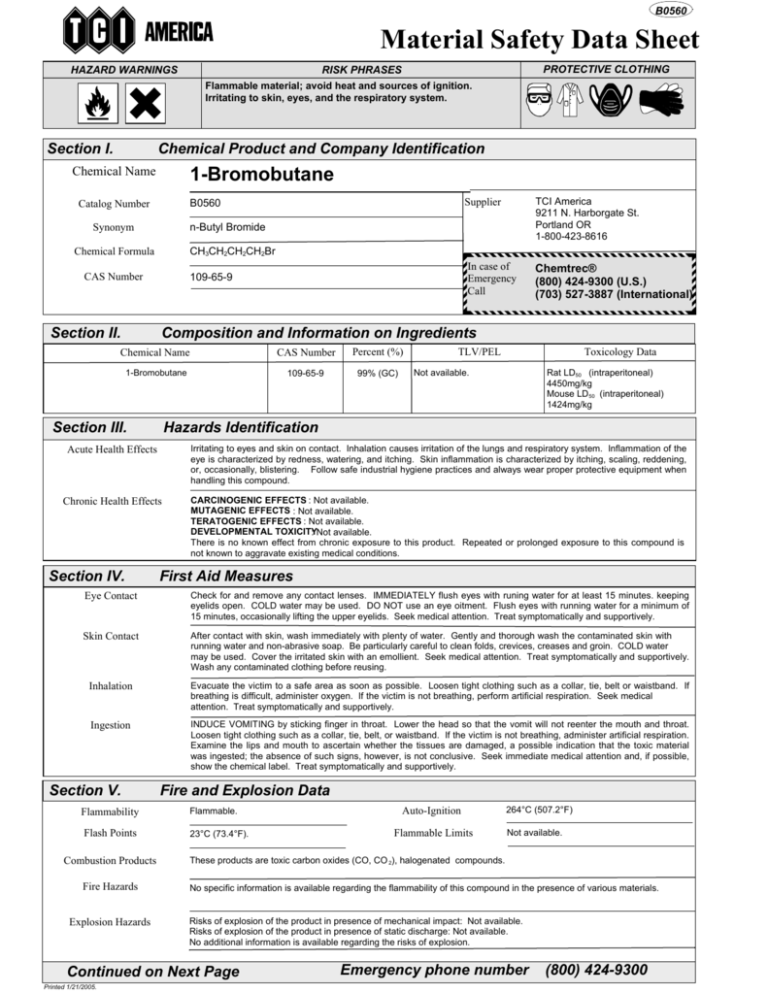
B0560 Material Safety Data Sheet PROTECTIVE CLOTHING RISK PHRASES HAZARD WARNINGS Flammable material; avoid heat and sources of ignition. Irritating to skin, eyes, and the respiratory system. Section I. Chemical Product and Company Identification Chemical Name 1-Bromobutane B0560 Catalog Number TCI America 9211 N. Harborgate St. Portland OR 1-800-423-8616 In case of Emergency Call Chemtrec® (800) 424-9300 (U.S.) (703) 527-3887 (International) n-Butyl Bromide Synonym CH3CH2CH2CH2Br Chemical Formula 109-65-9 CAS Number Section II. Supplier Composition and Information on Ingredients Chemical Name CAS Number Percent (%) 1-Bromobutane 109-65-9 99% (GC) Section III. Toxicology Data TLV/PEL Not available. Rat LD50 (intraperitoneal) 4450mg/kg Mouse LD 50 (intraperitoneal) 1424mg/kg Hazards Identification Acute Health Effects Irritating to eyes and skin on contact. Inhalation causes irritation of the lungs and respiratory system. Inflammation of the eye is characterized by redness, watering, and itching. Skin inflammation is characterized by itching, scaling, reddening, or, occasionally, blistering. Follow safe industrial hygiene practices and always wear proper protective equipment when handling this compound. Chronic Health Effects CARCINOGENIC EFFECTS : Not available. MUTAGENIC EFFECTS : Not available. TERATOGENIC EFFECTS : Not available. DEVELOPMENTAL TOXICITY : Not available. There is no known effect from chronic exposure to this product. Repeated or prolonged exposure to this compound is not known to aggravate existing medical conditions. Section IV. First Aid Measures Eye Contact Check for and remove any contact lenses. IMMEDIATELY flush eyes with runing water for at least 15 minutes. keeping eyelids open. COLD water may be used. DO NOT use an eye oitment. Flush eyes with running water for a minimum of 15 minutes, occasionally lifting the upper eyelids. Seek medical attention. Treat symptomatically and supportively. Skin Contact After contact with skin, wash immediately with plenty of water. Gently and thorough wash the contaminated skin with running water and non-abrasive soap. Be particularly careful to clean folds, crevices, creases and groin. COLD water may be used. Cover the irritated skin with an emollient. Seek medical attention. Treat symptomatically and supportively. Wash any contaminated clothing before reusing. Inhalation Evacuate the victim to a safe area as soon as possible. Loosen tight clothing such as a collar, tie, belt or waistband. If breathing is difficult, administer oxygen. If the victim is not breathing, perform artificial respiration. Seek medical attention. Treat symptomatically and supportively. Ingestion INDUCE VOMITING by sticking finger in throat. Lower the head so that the vomit will not reenter the mouth and throat. Loosen tight clothing such as a collar, tie, belt, or waistband. If the victim is not breathing, administer artificial respiration. Examine the lips and mouth to ascertain whether the tissues are damaged, a possible indication that the toxic material was ingested; the absence of such signs, however, is not conclusive. Seek immediate medical attention and, if possible, show the chemical label. Treat symptomatically and supportively. Section V. Flammability Flash Points Combustion Products Fire Hazards Explosion Hazards Fire and Explosion Data Flammable. 23°C (73.4°F). Flammable Limits 264°C (507.2°F) Not available. These products are toxic carbon oxides (CO, CO 2), halogenated compounds. No specific information is available regarding the flammability of this compound in the presence of various materials. Risks of explosion of the product in presence of mechanical impact: Not available. Risks of explosion of the product in presence of static discharge: Not available. No additional information is available regarding the risks of explosion. Continued on Next Page Printed 1/21/2005. Auto-Ignition Emergency phone number (800) 424-9300 B0560 1-Bromobutane Fire Fighting Media and Instructions Section VI. Flammable liquid. SMALL FIRE: Use DRY chemicals, CO 2, alcohol foam or water spray. LARGE FIRE: Use alcohol foam, water spray or fog. Accidental Release Measures Spill Cleanup Instructions Section VII. Flammable liquid. Irritating material. Keep away from heat and sources of ignition. Mechanical exhaust required. Stop leak if without risk. Absorb with DRY earth, sand or other non-combustible material. DO NOT touch spilled material. Prevent entry into sewers, basements or confined areas; dike if needed. Eliminate all sources of ignition. Consult federal, state, and/or local authorities for assistance on disposal. Handling and Storage FLAMMABLE. IRRITANT. Do not breathe gas, fumes, vapor or spray. Always store away from incompatible compounds such as oxidizing agents, reducing agents. Handling and Storage Information Section VIII. Exposure Controls/Personal Protection Engineering Controls Provide exhaust ventilation or other engineering controls to keep the airborne concentrations of vapors below their respective threshold limit value. Ensure that eyewash station and safety shower is proximal to the work-station location. Splash goggles. Lab coat. Dust respirator. Boots. Gloves. Suggested protective clothing might not be sufficient; consult a specialist BEFORE handling this product. Personal Protection Exposure Limits Section IX. Page 2 Not available. Physical and Chemical Properties Solubility Colorless liquid. Physical state @ 20°C 1.276 Specific Gravity Molecular Weight Partition Coefficient 137.02 Insoluble in water. Soluble in alcohol, ether, acetone, and chloroform. Not available. Boiling Point 100 to 104°C Vapor Pressure 40 mm Hg @ 25°C Melting Point Not available. Vapor Density 4.7 1.4398 @ 20°C Refractive Index Critical Temperature Viscosity Section X. RTECS Number Routes of Exposure Toxicity Data Not available. Odor Not available. Not available. Taste Not available. This material is stable if stored under proper conditions. (See Section VII for instructions) Conditions of Instability Section XI. Not available. Stability and Reactivity Data Stability Incompatibilities Volatility Avoid excessive heat and light. Reactive with strong oxidizing agents, strong alkalis (bases), magnesium, sodium, and potassium. Toxicological Information EJ6225000 Eye contact. Ingestion. Inhalation. Skin contact. Rat LD50 (intraperitoneal) 4450mg/kg Mouse LD 50 (intraperitoneal) 1424mg/kg Chronic Toxic Effects CARCINOGENIC EFFECTS : Not available. MUTAGENIC EFFECTS : Not available. TERATOGENIC EFFECTS : Not available. DEVELOPMENTAL TOXICITY : Not available. There is no known effect from chronic exposure to this product. Repeated or prolonged exposure to this compound is not known to aggravate existing medical conditions. Acute Toxic Effects Irritating to eyes and skin on contact. Inhalation causes irritation of the lungs and respiratory system. Inflammation of the eye is characterized by redness, watering, and itching. Skin inflammation is characterized by itching, scaling, reddening, or, occasionally, blistering. Follow safe industrial hygiene practices and always wear proper protective equipment when handling this compound. Continued on Next Page Printed 1/21/2005. Emergency phone number (800) 424-9300 B0560 Section XII. 1-Bromobutane Ecological Information Not available. Ecotoxicity n-Butyl bromide's use in synthesis could result in its release to the environment through various waste streams. n-Butyl bromide is expected to have high mobility in soil. Volatilization of n-butyl bromide is expected from both moist and dry soils. In water, n-butyl bromide is expected to volatilize rapidly with estimated half-lives of 3.5 hours and 4.7 days from a model river and a model lake, respectively. Neutral hydrolysis may be an important fate process in aquatic systems, but bioconcentration and adsorption to sediment are not expected to be important. Insufficient data are available to determine the rate or importance of biodegradation of n-butyl bromide in soil or aquatic systems. n-Butyl bromide will exist in the vapor phase in the ambient atmosphere. If released to the atmosphere, it will degrade by reaction with photochemically produced hydroxyl radicals with an estimated half-life of approximately 7.4 days. Removal of n-butyl bromide from the atmosphere can occur through wet deposition. Exposure to n-butyl bromide can occur through dermal contact, inhalation, and ingestion. Environmental Fate Section XIII. Disposal Considerations Recycle to process, if possible. Consult your local or regional authorities. You may be able to dissolve or mix material with a combustible solvent and burn in a chemical incinerator equipped with an afterburner and scrubber system. Observe all federal, state, and local regulations when disposing of the substance. Waste Disposal Section XIV. Page 3 Transport Information DOT Classification DOT CLASS 3: Flammable liquid. UN1126 PIN Number Proper Shipping Name 1-Bromobutane Packing Group (PG) II DOT Pictograms Section XV. Other Regulatory Information and Pictograms TSCA Chemical Inventory (EPA) WHMIS Classification (Canada) EINECS Number (EEC) EEC Risk Statements WHMIS CLASS B-2: Flammable liquid with a flash point lower than 35°C (100°F). 203-691-9 R10- Flammable. R18- In use, may form flammable/explosive vapor-air mixture. R36/37/38- Irritating to eyes, respiratory system and skin. Japanese Regulatory Data Section XVI. This compound is ON the EPA Toxic Substances Control Act (TSCA) inventory list. Not available. Other Information Version 1.0 Validated on 8/31/2000. Printed 1/21/2005. Notice to Reader TCI laboratory chemicals are for research purposes only and are NOT intended for use as drugs, food additives, households, or pesticides. The information herein is believed to be correct, but does not claim to be all inclusive and should be used only as a guide. Neither the above named supplier nor any of its subsidiaries assumes any liability whatsoever for the accuracy or completeness of the information contained herein. Final determination of suitability of any material is the sole responsibility of the user. All chemical reagents must be handled with the recognition that their chemical, physiological, toxicological, and hazardous properties have not been fully investigated or determined. All chemical reagents should be handled only by individuals who are familiar with their potential hazards and who have been fully trained in proper safety, laboratory, and chemical handling procedures. Although certain hazards are described herein, we can not guarantee that these are the only hazards which exist. Our MSDS sheets are based only on data available at the time of shipping and are subject to change without notice as new information is obtained. Avoid long storage periods since the product is subject to degradation with age and may become more dangerous or hazardous. It is the responsibility of the user to request updated MSDS sheets for products that are stored for extended periods. Disposal of unused product must be undertaken by qualified personnel who are knowledgeable in all applicable regulations and follow all pertinent safety precautions including the use of appropriate protective equipment (e.g. protective goggles, protective clothing, breathing equipment, facial mask, fume hood). For proper handling and disposal, always comply with federal, state, and local regulations. Printed 1/21/2005.

